[English] 日本語
 Yorodumi
Yorodumi- PDB-9f6e: Human DNA polymerase epsilon bound to DNA and PCNA (ajar conformation) -
+ Open data
Open data
- Basic information
Basic information
| Entry | Database: PDB / ID: 9f6e | ||||||
|---|---|---|---|---|---|---|---|
| Title | Human DNA polymerase epsilon bound to DNA and PCNA (ajar conformation) | ||||||
 Components Components |
| ||||||
 Keywords Keywords | REPLICATION / DNA / polymerase / epsilon / PCNA / leading strand / human / replisome / proofreading | ||||||
| Function / homology |  Function and homology information Function and homology informationDNA replication initiation / epsilon DNA polymerase complex / positive regulation of deoxyribonuclease activity / dinucleotide insertion or deletion binding / PCNA-p21 complex / mitotic telomere maintenance via semi-conservative replication / purine-specific mismatch base pair DNA N-glycosylase activity / nucleotide-excision repair, DNA gap filling / nuclear lamina / positive regulation of DNA-directed DNA polymerase activity ...DNA replication initiation / epsilon DNA polymerase complex / positive regulation of deoxyribonuclease activity / dinucleotide insertion or deletion binding / PCNA-p21 complex / mitotic telomere maintenance via semi-conservative replication / purine-specific mismatch base pair DNA N-glycosylase activity / nucleotide-excision repair, DNA gap filling / nuclear lamina / positive regulation of DNA-directed DNA polymerase activity / Polymerase switching / MutLalpha complex binding / Processive synthesis on the lagging strand / DNA replication proofreading / PCNA complex / single-stranded DNA 3'-5' DNA exonuclease activity / Telomere C-strand (Lagging Strand) Synthesis / Removal of the Flap Intermediate / Mismatch repair (MMR) directed by MSH2:MSH3 (MutSbeta) / Mismatch repair (MMR) directed by MSH2:MSH6 (MutSalpha) / Transcription of E2F targets under negative control by DREAM complex / Processive synthesis on the C-strand of the telomere / Polymerase switching on the C-strand of the telomere / replisome / response to L-glutamate / Removal of the Flap Intermediate from the C-strand / Hydrolases; Acting on ester bonds; Exodeoxyribonucleases producing 5'-phosphomonoesters / response to dexamethasone / DNA synthesis involved in DNA repair / histone acetyltransferase binding / DNA polymerase processivity factor activity / G1/S-Specific Transcription / leading strand elongation / nuclear replication fork / replication fork processing / SUMOylation of DNA replication proteins / PCNA-Dependent Long Patch Base Excision Repair / Activation of the pre-replicative complex / embryonic organ development / response to cadmium ion / translesion synthesis / estrous cycle / mismatch repair / cyclin-dependent protein kinase holoenzyme complex / base-excision repair, gap-filling / DNA polymerase binding / epithelial cell differentiation / liver regeneration / TP53 Regulates Transcription of Genes Involved in G2 Cell Cycle Arrest / positive regulation of DNA repair / Translesion synthesis by REV1 / Translesion synthesis by POLK / positive regulation of DNA replication / replication fork / nuclear estrogen receptor binding / Translesion synthesis by POLI / Gap-filling DNA repair synthesis and ligation in GG-NER / male germ cell nucleus / Termination of translesion DNA synthesis / G1/S transition of mitotic cell cycle / Recognition of DNA damage by PCNA-containing replication complex / Translesion Synthesis by POLH / receptor tyrosine kinase binding / HDR through Homologous Recombination (HRR) / DNA-templated DNA replication / Dual Incision in GG-NER / cellular response to xenobiotic stimulus / cellular response to hydrogen peroxide / Dual incision in TC-NER / Gap-filling DNA repair synthesis and ligation in TC-NER / cellular response to UV / response to estradiol / mitotic cell cycle / E3 ubiquitin ligases ubiquitinate target proteins / heart development / 4 iron, 4 sulfur cluster binding / chromatin organization / DNA-directed DNA polymerase / damaged DNA binding / DNA-directed DNA polymerase activity / DNA replication / chromosome, telomeric region / nuclear body / nucleotide binding / centrosome / chromatin binding / chromatin / protein-containing complex binding / enzyme binding / negative regulation of transcription by RNA polymerase II / DNA binding / extracellular exosome / zinc ion binding / nucleoplasm / identical protein binding / nucleus / plasma membrane Similarity search - Function | ||||||
| Biological species |  Homo sapiens (human) Homo sapiens (human)synthetic construct (others) | ||||||
| Method | ELECTRON MICROSCOPY / single particle reconstruction / cryo EM / Resolution: 3.74 Å | ||||||
 Authors Authors | Roske, J.J. / Yeeles, J.T.P. | ||||||
| Funding support |  United Kingdom, 1items United Kingdom, 1items
| ||||||
 Citation Citation |  Journal: Nat Struct Mol Biol / Year: 2024 Journal: Nat Struct Mol Biol / Year: 2024Title: Structural basis for processive daughter-strand synthesis and proofreading by the human leading-strand DNA polymerase Pol ε. Authors: Johann J Roske / Joseph T P Yeeles /  Abstract: During chromosome replication, the nascent leading strand is synthesized by DNA polymerase epsilon (Pol ε), which associates with the sliding clamp processivity factor proliferating cell nuclear ...During chromosome replication, the nascent leading strand is synthesized by DNA polymerase epsilon (Pol ε), which associates with the sliding clamp processivity factor proliferating cell nuclear antigen (PCNA) to form a processive holoenzyme. For high-fidelity DNA synthesis, Pol ε relies on nucleotide selectivity and its proofreading ability to detect and excise a misincorporated nucleotide. Here, we present cryo-electron microscopy (cryo-EM) structures of human Pol ε in complex with PCNA, DNA and an incoming nucleotide, revealing how Pol ε associates with PCNA through its PCNA-interacting peptide box and additional unique features of its catalytic domain. Furthermore, by solving a series of cryo-EM structures of Pol ε at a mismatch-containing DNA, we elucidate how Pol ε senses and edits a misincorporated nucleotide. Our structures delineate steps along an intramolecular switching mechanism between polymerase and exonuclease activities, providing the basis for a proofreading mechanism in B-family replicative polymerases. | ||||||
| History |
|
- Structure visualization
Structure visualization
| Structure viewer | Molecule:  Molmil Molmil Jmol/JSmol Jmol/JSmol |
|---|
- Downloads & links
Downloads & links
- Download
Download
| PDBx/mmCIF format |  9f6e.cif.gz 9f6e.cif.gz | 381.6 KB | Display |  PDBx/mmCIF format PDBx/mmCIF format |
|---|---|---|---|---|
| PDB format |  pdb9f6e.ent.gz pdb9f6e.ent.gz | 295.6 KB | Display |  PDB format PDB format |
| PDBx/mmJSON format |  9f6e.json.gz 9f6e.json.gz | Tree view |  PDBx/mmJSON format PDBx/mmJSON format | |
| Others |  Other downloads Other downloads |
-Validation report
| Summary document |  9f6e_validation.pdf.gz 9f6e_validation.pdf.gz | 1.5 MB | Display |  wwPDB validaton report wwPDB validaton report |
|---|---|---|---|---|
| Full document |  9f6e_full_validation.pdf.gz 9f6e_full_validation.pdf.gz | 1.5 MB | Display | |
| Data in XML |  9f6e_validation.xml.gz 9f6e_validation.xml.gz | 66 KB | Display | |
| Data in CIF |  9f6e_validation.cif.gz 9f6e_validation.cif.gz | 98 KB | Display | |
| Arichive directory |  https://data.pdbj.org/pub/pdb/validation_reports/f6/9f6e https://data.pdbj.org/pub/pdb/validation_reports/f6/9f6e ftp://data.pdbj.org/pub/pdb/validation_reports/f6/9f6e ftp://data.pdbj.org/pub/pdb/validation_reports/f6/9f6e | HTTPS FTP |
-Related structure data
| Related structure data |  50223MC  9f6dC  9f6fC 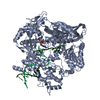 9f6iC 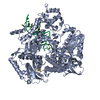 9f6jC 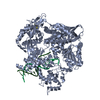 9f6kC 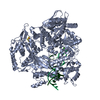 9f6lC M: map data used to model this data C: citing same article ( |
|---|---|
| Similar structure data | Similarity search - Function & homology  F&H Search F&H Search |
- Links
Links
- Assembly
Assembly
| Deposited unit | 
|
|---|---|
| 1 |
|
- Components
Components
-Protein , 2 types, 4 molecules ABCD
| #1: Protein | Mass: 138137.562 Da / Num. of mol.: 1 / Mutation: D275A E277A Source method: isolated from a genetically manipulated source Source: (gene. exp.)  Homo sapiens (human) / Gene: POLE, POLE1 / Production host: Homo sapiens (human) / Gene: POLE, POLE1 / Production host:  Trichoplusia ni (cabbage looper) Trichoplusia ni (cabbage looper)References: UniProt: Q07864, DNA-directed DNA polymerase, Hydrolases; Acting on ester bonds; Exodeoxyribonucleases producing 5'-phosphomonoesters |
|---|---|
| #2: Protein | Mass: 28795.752 Da / Num. of mol.: 3 Source method: isolated from a genetically manipulated source Source: (gene. exp.)  Homo sapiens (human) / Gene: PCNA / Production host: Homo sapiens (human) / Gene: PCNA / Production host:  |
-DNA chain , 2 types, 2 molecules PT
| #3: DNA chain | Mass: 7074.585 Da / Num. of mol.: 1 Source method: isolated from a genetically manipulated source Source: (gene. exp.) synthetic construct (others) / Production host: synthetic construct (others) |
|---|---|
| #4: DNA chain | Mass: 12033.732 Da / Num. of mol.: 1 Source method: isolated from a genetically manipulated source Source: (gene. exp.) synthetic construct (others) / Production host: synthetic construct (others) |
-Non-polymers , 2 types, 2 molecules 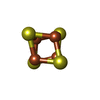
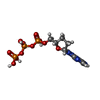

| #5: Chemical | ChemComp-SF4 / |
|---|---|
| #6: Chemical | ChemComp-DDS / |
-Details
| Has ligand of interest | N |
|---|---|
| Has protein modification | N |
-Experimental details
-Experiment
| Experiment | Method: ELECTRON MICROSCOPY |
|---|---|
| EM experiment | Aggregation state: PARTICLE / 3D reconstruction method: single particle reconstruction |
- Sample preparation
Sample preparation
| Component | Name: Quaternary Complex of human leading strand polymerase epsilon, Proliferating cell nuclear antigen (PCNA), substrate DNA and incoming nucleotide. Type: COMPLEX / Entity ID: #1-#4 / Source: RECOMBINANT |
|---|---|
| Molecular weight | Experimental value: NO |
| Source (natural) | Organism:  Homo sapiens (human) Homo sapiens (human) |
| Source (recombinant) | Organism:  Trichoplusia ni (cabbage looper) Trichoplusia ni (cabbage looper) |
| Buffer solution | pH: 7.5 |
| Specimen | Embedding applied: NO / Shadowing applied: NO / Staining applied: NO / Vitrification applied: YES |
| Vitrification | Cryogen name: ETHANE |
- Electron microscopy imaging
Electron microscopy imaging
| Experimental equipment |  Model: Titan Krios / Image courtesy: FEI Company |
|---|---|
| Microscopy | Model: FEI TITAN KRIOS |
| Electron gun | Electron source:  FIELD EMISSION GUN / Accelerating voltage: 300 kV / Illumination mode: FLOOD BEAM FIELD EMISSION GUN / Accelerating voltage: 300 kV / Illumination mode: FLOOD BEAM |
| Electron lens | Mode: BRIGHT FIELD / Nominal defocus max: 3000 nm / Nominal defocus min: 800 nm |
| Image recording | Electron dose: 40.08 e/Å2 / Film or detector model: GATAN K3 BIOQUANTUM (6k x 4k) |
- Processing
Processing
| EM software | Name: PHENIX / Version: 1.21_5207 / Category: model refinement |
|---|---|
| CTF correction | Type: PHASE FLIPPING AND AMPLITUDE CORRECTION |
| 3D reconstruction | Resolution: 3.74 Å / Resolution method: FSC 0.143 CUT-OFF / Num. of particles: 69268 / Symmetry type: POINT |
| Refinement | Cross valid method: NONE |
 Movie
Movie Controller
Controller








 PDBj
PDBj


















































